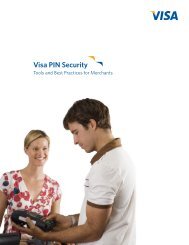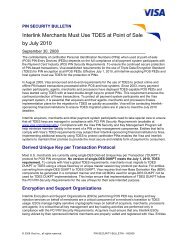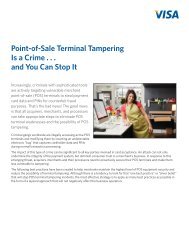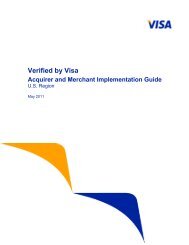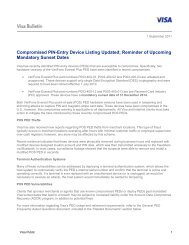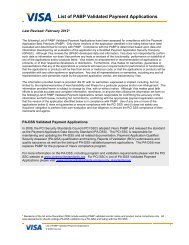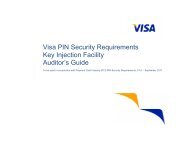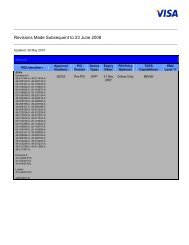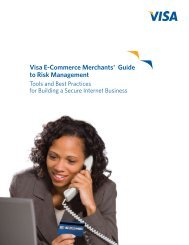Issuer PIN Security Guidelines - Visa
Issuer PIN Security Guidelines - Visa
Issuer PIN Security Guidelines - Visa
You also want an ePaper? Increase the reach of your titles
YUMPU automatically turns print PDFs into web optimized ePapers that Google loves.
• The control number should be generated and conveyed to the cardholder<br />
in such a way, e .g . by using a <strong>PIN</strong> mailer, so that no one other than the<br />
cardholder can associate the control number with that cardholder without<br />
detection .<br />
• The control number should be communicated to the cardholder in such a<br />
way that no one other than the cardholder can have access to it without<br />
detection . The system should have no way of associating a control number<br />
or the authentication values with a specific cardholder’s name, telephone<br />
number, address or account number .<br />
• The <strong>PIN</strong> advice function should exchange only strings of numbers, (a control<br />
number and authentication values) with the issuer <strong>PIN</strong> notification system .<br />
• The <strong>PIN</strong> notification system should re-associate the control number with a<br />
specific account number, validate the cardholder (or the transaction if there<br />
is no mechanism for pre-registration of the cardholder as in an anonymous<br />
gift card) using the authentication values and retrieve the cardholder <strong>PIN</strong> for<br />
that account number .<br />
• The control number/<strong>PIN</strong>/authentication values string should not be logged<br />
and should be deleted immediately after use .<br />
• The <strong>PIN</strong> advice system should be designed and operated under strictly<br />
enforced procedures such that no individual is able to associate any control<br />
number, <strong>PIN</strong> or authentication values with any specific account number .<br />
• The <strong>PIN</strong> delivery to the PC should not be associated with any cardholder<br />
account data .<br />
• Cardholder <strong>PIN</strong> advice may be treated as equivalent to card activation .<br />
• Internet <strong>PIN</strong> advice should be protected using a secure channel established<br />
between the client application on the user’s PC and the server according to<br />
the principles of ISO/IEC 11770 . In addition the implementation should take<br />
into account MITB and other malware attacks .<br />
• Payment-system brand requirements may apply to third parties outsourced<br />
to perform the service .<br />
• An issuer should ensure that the association of cardholder authentication<br />
credentials with the control number does not weaken the principle that the<br />
control number cannot be used to determine a specific account .<br />
• Cardholder authentication should not be performed by the internet server . It<br />
should be performed by the back end issuer host system and only after the<br />
control number is re-associated with the specific account .<br />
• Web servers should be configured to disable client side caching of web<br />
pages that display <strong>PIN</strong> and associated data during the internet session .<br />
<strong>Issuer</strong> <strong>PIN</strong> <strong>Security</strong> <strong>Guidelines</strong> 4 3<br />
<strong>Visa</strong> Public © 2010 <strong>Visa</strong>. All Rights Reserved.



